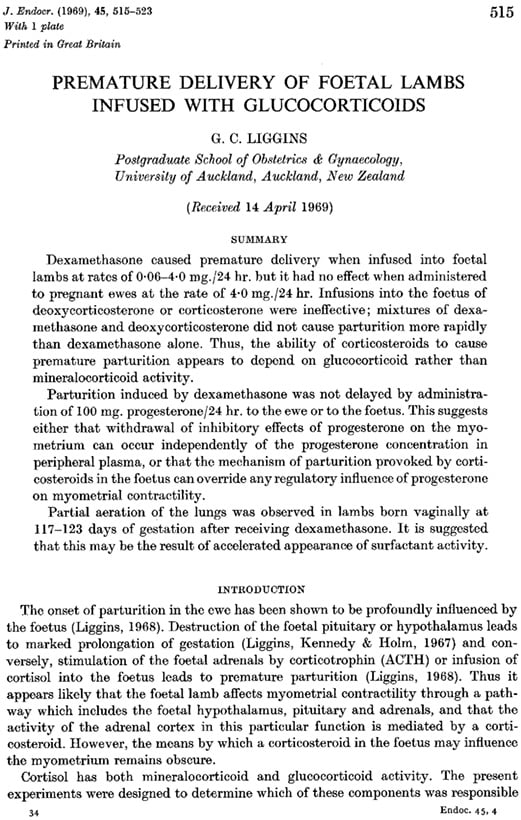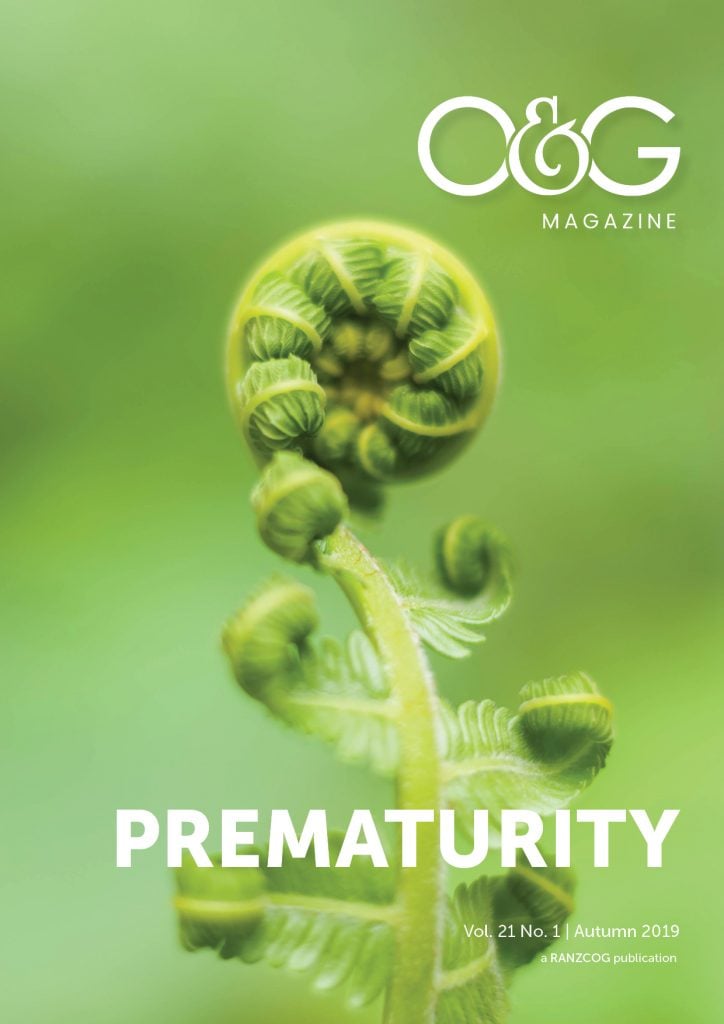Arguably the greatest contribution to the improvement in health outcomes for babies born preterm over the last 50 years has been the use of antenatal corticosteroids. This article provides a brief overview of the history of this remarkable breakthrough, with a particular focus on the contribution from Australia and New Zealand. More detail can be found in the Wellcome Witnesses to Twentieth Century Medicine report.1
Liggins’ original observations
In the 1960s, Dr (later Professor Sir) Graham (Mont) Liggins, an obstetrician working at National Women’s Hospital, Auckland, was studying the initiation of labour in sheep. His hypothesis, novel at the time, was that the fetus, rather than the mother, provided the key trigger for the onset of labour, and that fetal glucocorticoids were that trigger. He showed that inhibiting fetal glucocorticoid production by fetal hypophysectomy or adrenalectomy prevented the onset of labour, whereas administration of a glucocorticoid to the fetus, either directly or via the ewe and placenta, resulted in labour, independent of gestation length.
Lambs born preterm die, with immature lungs that do not inflate. Liggins’s key observation was that a lamb born preterm after glucocorticoid administration was alive and breathing and had lungs that did inflate. The conclusion of his paper, published in 1969, noted that ‘Partial aeration of the lungs was observed in lambs born vaginally… after receiving dexamethasone… this may be the result of accelerated appearance of surfactant activity’.2
Liggins, Howie and their randomised trial
Liggins reasoned that if glucocorticoids accelerated lung maturation in sheep, they should also do so in human babies. At the time, most preterm babies died of lung disease due to surfactant deficiency (respiratory distress syndrome [RDS]), and the first infant ventilators were just being introduced. At National Women’s Hospital, the only neonatologist able to ventilate babies was A/Prof Ross Howie. With remarkable speed, Liggins and Howie devised a randomised, placebo-controlled trial of antenatal corticosteroids and began recruiting women in 1969.
The first report of this trial, with outcomes from 282 women, was published in Pediatrics in 1972,3 having been rejected by Lancet on the grounds that ‘it lacked general interest’.4 The findings were indeed miraculous. Early neonatal mortality was reduced from 15 per cent to three per cent, and RDS from 26 per cent to 9 per cent. Although this is the most widely cited publication from that trial, recruitment actually continued until February 1974, with 1142 women randomised along with 1248 babies. The earlier beneficial findings were confirmed in the larger study.5
Several other important observations were made in that first trial. The greatest benefit was seen in babies born between one and seven days after corticosteroid administration; doubling the dose of corticosteroids did not further improve outcomes; and there was no evidence of increased risk of infection for mother or baby.6

Figure 1. First page of Liggin’s original research paper
Subsequent trials and data synthesis
Many subsequent trials were undertaken. All were consistent with the initial findings, showing a reduction in the incidence and severity of RDS. Most also showed a reduction in mortality, although as neonatal ventilation, continuous positive airway pressure (CPAP) and then artificial surfactant became more widely available over the next two decades, overall mortality continued to decrease.
The first systematic synthesis of the evidence from randomised trials of antenatal glucocorticoids in 1981, led by Patricia Crowley, already included four trials. When updated in the landmark book Effective Care in Pregnancy and Childbirth,7 it included 12 trials and clearly showed that antenatal glucorticoids given to women at risk of preterm birth approximately halved the risk of death and of RDS in their babies, and also the risk of periventricular haemorrhage and necrotising enterocolitis, without altering the risk of infection.
As techniques for systematic review and meta-analysis further developed, the UK Cochrane Centre in 1992, and subsequently the Cochrane Collaboration, adopted as their logo an image of the meta-analysis of seven randomised trials of antenatal corticosteroids. Sir Iain Chalmers related that this image was selected because ‘We wanted to show that within ten years of the Liggins and Howie trial, there had been crystal-clear evidence that this was a very important way of reducing neonatal deaths….This…information had been available more than a decade earlier, yet it was still not being acted upon sufficiently in practice….tens of thousands of babies had suffered and died unnecessarily…because information had not been assembled in a systematic review and meta-analysis to show the strength of the evidence”.8
By 2006, the Cochrane systematic review of antenatal corticosteroids by Devender Roberts from Liverpool and Stuart Dalziel from Auckland included 21 studies (3885 women and 4269 infants).9 It not only confirmed consistent benefits of antenatal glucocorticoids for infants without adverse effects on the mother, but also included other analyses that addressed many clinical debates still ongoing some 30 years after the original trial. These included that the benefits were similar regardless of the decade in which the trials were undertaken, and hence independent of other improvements in antenatal and neonatal care; were similar in women with ruptured membranes, pregnancy-related hypertension syndromes and multiple pregnancy; independent of gestational age at birth; and present even in babies born less than 24 hours after the first dose. The limited available data on longer term outcomes showed no effect on growth in childhood, reduced risk of developmental delay and no adverse effects into adulthood. The authors concluded that ‘A single course of antenatal corticosteroids should be considered routine for preterm delivery with few exceptions’.10
Dissemination and uptake
Despite the remarkable benefits of antenatal corticosteroids, uptake of this treatment was variable. In Australia and New Zealand, the majority of eligible women were receiving this treatment in the 1980s, but in the early 1990s the estimated rate in both the UK and the US was still only 10 to 20 per cent.11 12
This finally began to change after active implementation strategies following the publication of an NIH Consensus Statement,13 which concluded that ‘Antenatal corticosteroid therapy is indicated for women at risk of premature delivery with few exceptions and will result in a substantial decrease in neonatal morbidity and mortality, as well as substantial savings in healthcare costs.’
Usage subsequently rose around the world. In 2016, 89 per cent of mothers of babies born before 34 weeks and admitted to NICU in Australia or New Zealand received antenatal corticosteroids.14
Long-term concerns
Part of the reason for the relatively slow uptake related to concerns about the long-term safety of antenatal exposure to drugs with such diverse actions as corticosteroids. In the 1990s, there was considerable focus on the findings of David Barker, from Southampton, that events in early life could have lifelong effects on cardio-metabolic health. Animal studies demonstrated that early exposure to excess glucocorticoids permanently altered blood pressure and glucose tolerance in the offspring. The underlying mechanisms were elucidated in laboratory animals and increasingly supported by observational studies in human pregnancy.
At the same time, with the increased use of antenatal corticosteroids following the Consensus Statement, the pendulum swung, from underuse to overuse. There began to appear case reports of women given multiple, repeat doses of corticosteroids and adverse outcomes, including death, in the infant.
In part to address these concerns, there were renewed attempts to evaluate the long-term effects of exposure to antenatal corticosteroids. Observational cohort studies provided conflicting and low-quality evidence, particularly as women at risk of preterm birth who received corticosteroids were inevitably different from those who did not. However, some studies did support concerns about possible adverse effects on later growth, health and behaviour.
Much higher quality evidence was required from follow up of participants in the early randomised trials. A Dutch study in 2000 reported no adverse effects in a small cohort of 20 year olds.15 Liggins and Howie generously gave permission for Jane Harding in Auckland to use the original trial records, and Stuart Dalziel used these to undertake 30-year follow up. Remarkably, although the records only showed the name of the mother and the date of birth and sex (but not name) of the baby, 72 per cent of the cohort were traced and 534 were studied. There were no differences between corticosteroid and placebo exposed groups in a range of health and wellbeing outcomes, including body size, blood pressure, blood lipids, lung function, bone density, cognitive function, psychiatric morbidity and health-related quality of life.16 17 Those exposed to corticosteroids had a small increase in insulin response to an oral glucose tolerance challenge, raising the possibility of a small effect on insulin sensitivity of no clinical significance. These data have provided crucial reassurance about the long-term safety of antenatal corticosteroids.
Repeat antenatal corticosteroids
In the original trial, Liggins and Howie noted that ‘Time relations of therapy were important; it was effective only if delivery could be delayed for at least 24 hours, and no longer than seven days … This suggests that if very premature delivery has not occurred within seven days, and again threatens, therapy might need to be repeated at intervals of not less than seven days …’.18 This observation resulted in repeat courses of corticosteroids being given from the 1970s to many women in Australia and New Zealand, although without any substantial supporting evidence. The pendulum swing to widespread administration in the late 1990s was accompanied by many studies in laboratory animals demonstrating adverse effects of repeat antenatal corticosteroids, particularly on growth and neurological development of the offspring. Sheep studies, led by John Newnham and Alan Jobe in Perth, were particularly influential. Concerns about possible adverse consequences led to calls for randomised trials to provide the urgently needed high-quality evidence about the effects of repeat courses of antenatal corticosteroids in women.
One of the largest and earliest studies was the Australian and New Zealand collaborative trial, ACTORDS, led by Caroline Crowther from Adelaide, that recruited 982 women from 23 hospitals in Australia and New Zealand.19 Findings from this and, now, nine other randomised trials have been incorporated into a Cochrane Review of data from 4733 women and 5700 babies.20 The authors (all from Australia and New Zealand) report that, in women who remain at risk of preterm birth after an initial course of corticosteroids, babies exposed to additional doses have less RDS and major neonatal morbidity, but a small reduction in size at birth. The number of women needing to be treated to prevent one case of RDS is actually similar for both single (12; 95 per cent confidence intervals 7–14) and repeat courses of corticosteroids (17; 11–32). Importantly, follow up of the ACTORDS trial participants into mid-childhood has shown no effects on neurodevelopment or growth,21 and more detailed physiological studies by Dr Chris McKinlay, from Auckland, have shown no effects on cardiovascular and metabolic risk factors.22 The 2015 Australian and New Zealand Guidelines on antenatal corticosteroids therefore recommend that repeat antenatal corticosteroids should be used in women at risk of imminent, preterm birth at less than 33 weeks, not less than seven days following a single course of corticosteroids.23
Although the effects of antenatal corticosteroids have been studied in thousands of women and babies over the last 50 years, many questions remain unanswered. The Clinical Practice Guidelines24 included 12 recommendations for further research; some of which are being addressed in studies planned or in progress in Australia and New Zealand.
The clinically recommended dose of corticosteroid is still based on that chosen by Liggins and Howie, although current sheep studies in Perth are exploring other dosing schedules.
Betamethasone and dexamethasone are both recommended, with little evidence regarding whether one is safer or more effective. The A*STEROID Trial, a collaborative randomised trial led by Caroline Crowther, has recently completed recruitment of 1346 women from 14 Australian and New Zealand centres comparing the two drugs and will help answer this important question.25
The multicentre C*STEROID Trial, led by Dr Katie Groom, Auckland, will assess use of antenatal betamethasone compared to placebo prior to planned caesarian section late preterm and at term on RDS and neonatal hypoglycaemia.
The planned collaborative PRECeDE Trial, led by A/Prof Jo Said, Melbourne, will assess whether antenatal corticosteroids prior to elective caesarean section in women with diabetes prevents RDS.
Concerns also remain about the very long-term effects of antenatal glucocorticoid exposure. Follow up in Auckland of the original Liggins and Howie cohort into old age, and of the ACTORDS cohort into adulthood, may help address these in the future.
New Zealand and Australian researchers and clinicians continue to make an enormous contribution to the worldwide efforts to improve outcomes after preterm birth by optimising the use of antenatal glucocorticoids.
References
- Prenatal Corticosteroids for reducing morbidity and mortality after preterm birth. Wellcome Witnesses to Twentieth Century Medicine Volume 25. Reynolds LA, Tansey EM (Eds). The Wellcome Trust Centre for the History of Medicine at UCL, 2005. Available from www.histmodbiomed.org/witsem/vol25.html.
- Liggins GC. Premature delivery of foetal lambs infused with glucocorticoids. J Endo. 1969:45;515-23.
- Liggins GC, Howie RN. A controlled trial of antepartum glucocorticoid treatment for prevention of the respiratory distress syndrome in premature infants. Pediatrics 1972:50;515-25.
- Prenatal Corticosteroids for reducing morbidity and mortality after preterm birth. Wellcome Witnesses to Twentieth Century Medicine Volume 25. Reynolds LA, Tansey EM (Eds). The Wellcome Trust Centre for the History of Medicine at UCL, 2005. Available from www.histmodbiomed.org/witsem/vol25.html.
- Howie RN, Liggins GC. The New Zealand study of antepartum glucocorticoid treatment in lung development. Biological and Clinical Perspectives Vol II. Farrell PM (Ed). Academic Press, 1982. p255-65.
- Howie RN, Liggins GC. The New Zealand study of antepartum glucocorticoid treatment in lung development. Biological and Clinical Perspectives Vol II. Farrell PM (Ed). Academic Press, 1982. p255-65.
- Crowley P. Promoting pulmonary maturity. Effective Care in Pregnancy and Childbirth. Chalmers I, Enkin M, Keirse MJNC (Eds). Oxford University Press, Oxford, 1989. Chapter 45, p746-64.
- Prenatal Corticosteroids for reducing morbidity and mortality after preterm birth. Wellcome Witnesses to Twentieth Century Medicine Volume 25. Reynolds LA, Tansey EM (Eds). The Wellcome Trust Centre for the History of Medicine at UCL, 2005. Available from www.histmodbiomed.org/witsem/vol25.html.
- Roberts D, Dalziel S. Antenatal corticosteroids for accelerating fetal lung maturation for women at risk of preterm birth. The Cochrane Library. 2006, Issue 3.
- Roberts D, Dalziel S. Antenatal corticosteroids for accelerating fetal lung maturation for women at risk of preterm birth. The Cochrane Library. 2006, Issue 3.
- Prenatal Corticosteroids for reducing morbidity and mortality after preterm birth. Wellcome Witnesses to Twentieth Century Medicine Volume 25. Reynolds LA, Tansey EM (Eds). The Wellcome Trust Centre for the History of Medicine at UCL, 2005. Available from www.histmodbiomed.org/witsem/vol25.html.
- National Institutes of Health (NIH) Consensus Statement. Effect of corticosteroids for fetal maturation on perinatal outcomes. Consensus Statement. 1994:12;1-24.
- National Institutes of Health (NIH) Consensus Statement. Effect of corticosteroids for fetal maturation on perinatal outcomes. Consensus Statement. 1994:12;1-24.
- Chow SSW, Creighton P, Kander V, et al. Report of the Australian and New Zealand Neonatal Network 2016. Sydney: ANZNN.
- Dessens AB, Haas HS, Koppe JG. Twenty-year follow-up of antenatal corticosteroid treatment. Pediatrics. 2000;105:e77.
- Dalziel SR, Walker NK, Parag V, et al. Cardiovascular risk following exposure to antenatal betamethasone: Thirty-year follow-up of a randomised controlled trial. Lancet. 2005:365;1856-62.
- Dalziel SR, Lim VK, Lambert A, et al. Antenatal exposure to betamethasone: psychological functioning and health related quality of life 31 years after inclusion in a randomised controlled trial. BMJ. 2005:331;665-71.
- Howie RN, Liggins GC. The New Zealand study of antepartum glucocorticoid treatment in lung development. Biological and Clinical Perspectives Vol II. Farrell PM (Ed). Academic Press, 1982. p255-65.
- Crowther CA, Haslam RR, Hiller JE, et al. Neonatal respiratory distress syndrome after repeat exposure to antenatal corticosteroids: a randomised controlled trial. Lancet. 2006:367;1913-9.
- Crowther CA, McKinlay CJD, Middleton P, et al. Repeat doses of prenatal corticosteroids for women at risk of preterm birth for improving neonatal health outcomes. Cochrane Database of Systematic Reviews. 2015. Issue 7, Art. No: CD003935.
- Crowther CA, Anderson PJ, McKinlay CJD, et al. Mid-childhood outcomes of repeat antenatal corticosteroids: a randomized controlled trial. Pediatrics. 2016: 138, e20160947.
- McKinlay CJD, Cutfield WS, Battin MR, et al. Cardiovascular risk factors in children after repeat doses of antenatal glucocorticoids: an RCT. Pediatrics. 2015:135;e405-15.
- Antenatal Corticosteroid Clinical Practice Guidelines Panel. Antenatal corticosteroids given to women prior to birth to improve fetal, infant, child and adult health: Clinical Practice Guidelines. 2015. Liggins Institute, The University of Auckland, New Zealand. Available from www.ligginstrials.org/ANC_CPG.
- Antenatal Corticosteroid Clinical Practice Guidelines Panel. Antenatal corticosteroids given to women prior to birth to improve fetal, infant, child and adult health: Clinical Practice Guidelines. 2015. Liggins Institute, The University of Auckland, New Zealand. Available from www.ligginstrials.org/ANC_CPG.
- Crowther CA, Harding JE, Middleton PF, et al. Australasian randomised trial to evaluate the role of maternal intramuscular dexamethasone versus betamethasone prior to preterm birth to increase survival free of childhood neurosensory disability (A*STEROID): study protocol. BMC Pregnancy and Childbirth. 2013:13;104.







Leave a Reply